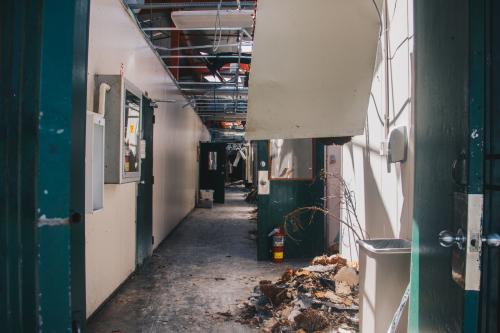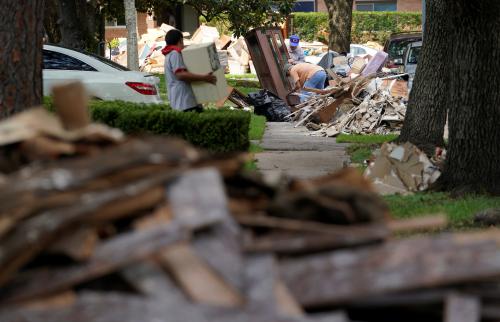Hurricane Maria has created widespread devastation for the 3.4 million American citizens living in Puerto Rico, leaving many without regular and consistent access to food, running water, and electricity. While attention is now focused on Congress providing sufficient funding to address the unfolding humanitarian crisis, Hurricane Maria has also laid bare some of the fundamental problems that plagued Puerto Rico before the storm. These problems include the relationship between Puerto Rico and the United States, which affects the ability of Puerto Rico to both respond effectively to the immediate crisis and begin to mount an economic recovery.
Natural disasters often expose underlying problems long ignored, like Hurricane Harvey and Houston’s longstanding water management issues, Hurricane Katrina and the deep poverty and inequality within New Orleans, and Superstorm Sandy and how we construct infrastructure to be resilient. There is an urgent need for federal resources in the form of grants to provide immediate disaster relief, but it is not too early to ask whether there will be sustained support and attention from the federal government to make good on its responsibility to the Americans living there.
The federal government should start by resolving the structural barriers stemming from the often unequal treatment of Puerto Rico.
On October 4, following President Trump’s trip to Puerto Rico and subsequent comments regarding its debts, Office of Management and Budget Director Mick Mulvaney stated, “We are not going to deal with the fundamental difficulties Puerto Rico had before the storm.” Then this week President Trump made clear his views that federal personnel cannot stay in Puerto Rico “forever” and that the responsibility of the impending financial crisis in Puerto Rico is of its own making. Neither of these statements suggest that there is an appropriate understanding of the “fundamental difficulties” confronting Puerto Rico, including that the responsibility to address at least some of them rests with the U.S. government. Without a significant and sustained federal response, hundreds of thousands will have no choice but to leave Puerto Rico for the mainland, increasing the challenges for Puerto Rico and imposing new costs on the U.S. government.
Before the storm
Puerto Rico has experienced a slow-moving economic crisis for a decade. The island has been in economic recession since 2006, with its GNP contracting by over 15 percent. Families have been leaving in droves, with the population declining by over 10 percent in the last decade. In 2014 and 2015 alone, roughly 150,000 people – nearly five percent of the island’s population – left for the mainland in search of opportunity elsewhere. Puerto Ricans, like all American citizens, have complete and flexible mobility within the United States, and with strong labor markets on the U.S. mainland (Florida’s unemployment rate is currently at four percent) the disparity in economic opportunity has been growing for several years, increasing the incentive to move.
Over the years, the government of Puerto Rico accumulated over $70 billion in debt, equivalent to roughly 100 percent of its annual economic output. But with an economy in steady decline and a large fiscal deficit, the government was unable to continue financing public services and make good on its growing obligations. In June 2016, the U.S. Congress passed PROMESA (Puerto Rico Oversight, Management and Economic Stability Act, or “promise” in Spanish), the result of a carefully constructed bipartisan compromise between the Obama Administration and Congress. That legislation put in place two critical tools: (1) an independent Financial Oversight and Management Board (“Oversight Board”) with the needed authority to manage Puerto Rico’s fiscal matters and financial restructuring in conjunction with elected officials and (2) a process for the orderly restructuring of Puerto Rico’s debts. While PROMESA addressed the most urgent issue – fiscal responsibility and debt restructuring – it did not provide needed tools to promote economic growth, such as providing workers in Puerto Rico access to an Earned Income Tax Credit, and it did not address the inadequacy in federal support for healthcare in Puerto Rico.
Puerto Rican Governor Ricardo Rosselló and the Oversight Board earlier this year agreed on a multi-year fiscal plan that established a combination of austerity measures and structural reforms to address the immediate fiscal issues, with the hope of establishing a foundation for economic recovery. Even with these changes, Puerto Rico would only be able to cover 25 percent of its debt service costs over the next decade. A recent analysis by Makoff and Setser demonstrates that while the plan reflects a substantial near-term economic contraction associated with austerity, the baseline economic projections are still likely overly optimistic, and that is before accounting for the plan’s assumption that out-migration would finally come to an end. While the basic tools created by PROMESA enabled a potential path forward on fiscal reforms and debt restructuring, achieving this difficult path would have required much to go right for Puerto Rico and for additional action on the part of the federal government to at least address Puerto Rico’s healthcare system. Then Hurricane Maria happened.
Economic and fiscal implications of the storm
The government of Puerto Rico is diverting its already limited near-term resources to relief efforts focused on saving lives and repairing critical infrastructure. Governor Rossello’s team has announced that it faces a liquidity crunch as soon as the end of October, prompting an additional request of $4.6 billion in immediate relief. And the impact of Maria on the economy for years to come is likely to be substantial. An analysis by Solomon Hsiang and Trevor Houser evaluates 1,300 major storms since 1950, and they estimate an expected drop in per capita GDP in Puerto Rico of 21 percent, a shockingly large number.
There is no doubt that the Oversight Board and the Governor must revise the fiscal plan by reducing the economic projections, accounting for the near-term shift in resources, and revising downward the government’s expected revenues. In addition, that revised plan should reassess the wisdom of austerity measures in the face of dramatic and urgent critical needs, ensuring sufficient resources for ongoing disaster relief efforts while avoiding unnecessary harm to an already fragile economy.
Three actions needed by the U.S. Government
The risk of outmigration to Puerto Rico’s future prospects is profound.
If hundreds of thousands of Puerto Ricans choose to leave rather than to rebuild, it will reduce the future potential recovery for the island, make it more difficult for the government of Puerto Rico to right the ship, and make it harder for those who choose to stay behind. Today, nearly all of Puerto Rico’s 1,300 schools are closed, leaving parents to decide whether to sacrifice as much as a full year of their child’s education or move to the mainland. A clear and immediate strategy is needed, and central to that strategy is the federal government taking the following three steps this year.
1. Announcing a sustained commitment to Puerto Rico’s future. A clear and public bipartisan commitment from Congress and the Administration to the long-term rebuilding effort is needed immediately. That commitment should include a commitment to a specific timeline for legislation and a framework around the types of federal support that will be provided, separate from the billions in near-term disaster relief being currently debated. This type of bold commitment is necessary to restoring hope to many currently considering whether or not to move, which would mitigate the risk of mass out-migration. If the devastation of Maria happened in Florida, there is little doubt that we would see such a bold commitment, but Puerto Rico is different. Americans living in Puerto Rico face different rules in many federal programs and laws and exert less political clout, being represented by the Commonwealth’s non-voting Resident Commissioner in the U.S. House of Representatives. In fact, a poll reported that only 54 percent of Americans recognized that people born in Puerto Rico are citizens. Uncertainty about the resolve of the federal government to provide ongoing support only increases the incentive for Puerto Rican families to leave. American Airlines announced that all tickets leaving San Juan are only $99.
2. Resolving the inadequacy of Puerto Rico’s Medicaid program. In the wake of a natural disaster, particularly with widescale devastation and inconsistent access to necessities, we would expect the demand on health services to rise substantially for a sustained period. Today, nearly half of Puerto Ricans rely on Medicaid, but unlike in states where the federal government pays a fixed share of Medicaid costs based on the state’s relative per capita income, for Puerto Rico and U.S. territories the federal share only covers up to 55 percent of costs up to a fixed annual funding cap. The Affordable Care Act provided a one-time supplemental federal grant of over $7 billion to be used to cover the federal share above the fixed annual cap, but that funding is nearly exhausted, after which Puerto Rico would be required to fund roughly 80 percent of its Medicaid program. By comparison, the state of Mississippi – which has the lowest per capita income amongst states – covers just 25 percent of its Medicaid costs. This challenge existed before Hurricane Maria. Failure to address this issue now, as part of any additional congressional package later this year, could significantly impair Puerto Rico’s future, and increase the likelihood that hundreds of thousands of people will leave Puerto Rico permanently.
3. Providing the needed capital and capacity to rebuild. Estimates of the damage to Puerto Rico are large, with Moody’s Analytics placing the cost at up to $95 billion, and insurance will cover little. The Puerto Rican government does not have current resources or access to capital markets. The economy is frozen, and there is a near-term risk that companies – including the multi-national biopharma firms that account for tens of thousands of high-paying jobs – will choose to shift capacity or relocate entirely. The infrastructure before the storm was already in a state of disrepair, and maintenance and needed capital expenditures had been delayed for years. Rebuilding Puerto Rico to enable economic recovery will require tens of billions of dollars in new capital investment, and that is only possible with substantial new multi-year resources from the U.S. federal government. This is not a bailout and these funds should not be siphoned to pay off Puerto Rico’s creditors. But the reality is that there will be little economy left without a massive and long-term rebuilding effort. Federal funds can be linked to a clear and public re-investment plan, developed by Puerto Rico to envision a new and stronger future. There have been proposals for innovative ways to rebuild Puerto Rico, such as using renewable energy to replace its fossil fuel burning power stations, and smart systems to manage Puerto Rico’s water supply. By way of comparison, Superstorm Sandy caused an estimated $65 billion in damage. The federal government provided tens of billions of dollars in repair and rebuilding relief, including $15 billion in Community Development Block Grant Disaster Recovery funding. In addition to capital, these solutions will require capacity, and Congress should assess additional tools that provide incentives for temporary capacity in equipment and expertise, without which the pace of rebuilding could be glacial.
The 3.4 million Americans in Puerto Rico are counting on their government in a time of remarkable and unprecedented need. It is the responsibility of the federal government – like it has been in response to other natural disasters – to support large-scale rebuilding. In addition, the federal government must take this moment to address the structural issues that will only exacerbate the difficult situation in Puerto Rico. The above three actions are a starting point, and more can be done across federal programs where unequal treatment only further encourages out-migration. Maria’s path of destruction has made these issues all too apparent, but the national attention on Puerto Rico may finally provide an opportunity to address them.






Commentary
Puerto Rico’s recovery requires a sustained federal commitment
October 13, 2017